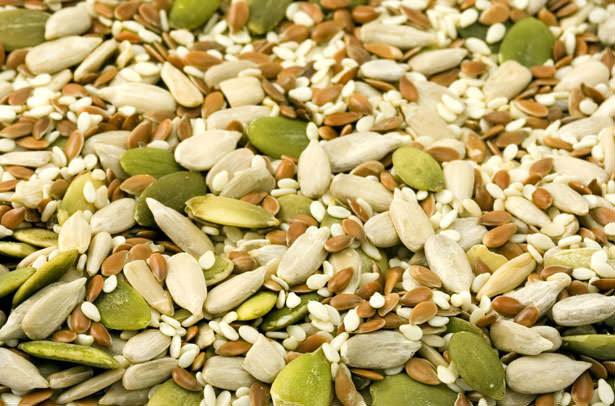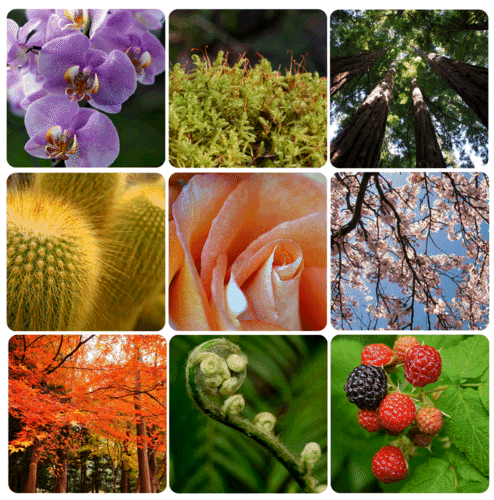7.4 植物分类
章节大纲
-
Do all plants grow from seeds ?
::所有的植物都是从种子中生长的吗?No, there are actually a few plants that do not make seeds. Whether or not a plant makes seeds is one criteria used to classify plants. How else could you distinguish between plants?
::不,实际上有几个植物不生产种子。一个植物是否生产种子是用来对植物进行分类的标准之一。你如何区分植物呢?Plant Classification
::植物分类Plants are formally divided into 12 phyla (plural for phylum), and these phyla are gathered into four groups ( Figure ). These four groups are based on the evolutionary history of significant features in plants:
::植物被正式分为12个植物(植物植物),这些植物分为四组(图)。这四组植物基于植物重要特征的演变历史:-
evolved first. They are distinct from the
because they keep the
embryo
inside of the reproductive structure after
. These plants do not have
vascular tissue
,
xylem
or
phloem
, to transport
nutrients
, water, and food. Examples include
mosses
,
liverworts
, and
hornworts
. Without vascular tissue, these plants do not grow very tall.
::这些植物没有血管组织、Xylem或phloem, 来传递养分、水和食物。例子包括苔丝、肝脏和角状动物。没有血管组织,这些植物不会长得很高。 -
Seedless vascular plants
evolved to have vascular tissue after the nonvascular plants but do not have seeds. Examples include the
ferns
, whisk ferns, club mosses, and
horsetails
. Vascular tissue allowed these plants to grow taller.
::无种子血管植物进化为非血管植物之后有血管组织,但没有种子。 例子包括小鹿、胡须、草苔和马尾。 血管组织允许这些植物生长更高。 -
Gymnosperms
evolved to have seeds but do not have
flowers
. Examples of gymnosperms include the Redwood, Fir, and Cypress trees.
Gymnos
means "naked" in Greek; the seeds of gymnosperms are naked, not protected by flowers.
::Gymnosperms进化为有种子但没有花。 体操场的例子包括红木、法尔和Cypress树。 Gymnos的意思是希腊语的“裸体 ” ; 体操场的种子是裸体的,没有鲜花的保护。 -
Flowering plants, or
, evolved to have vascular tissue, seeds, and flowers. Examples of angiosperms include magnolia trees, roses, tulips, and tomatoes.
::花朵植物,或者说,进化成血管组织、种子和花朵。 血管活性动物的例子包括木兰树、玫瑰、郁金香和番茄。
The plant kingdom contains a diversity of organisms.
::植物王国包含多种生物Summary
::摘要-
Nonvascular plants were the first plants to evolve and do not have vascular tissue.
::非血管植物是最早进化的植物,没有血管组织。 -
Seedless vascular plants have vascular tissue but do not have seeds.
::无种子血管植物有血管组织,但没有种子。 -
Gymnosperms have seeds but do not have flowers.
::Gymnosperms有种子,但没有花。 -
Angiosperms have vascular tissue, seeds, and flowers.
::血管膜有血管组织、种子和花朵。
Explore More
::探索更多Use the resource below to answer the questions that follow.
::利用以下资源回答以下问题。-
Plant Body Systems and Classification Part 1
at
(7:21)
::植物机体系统和分类第1部分(7:21)
-
What plant groups are included in non-vascular plants
::哪些植物组系列入非血管植物组 -
Give an example of a seedless vascular plant.
::举个无种子血管植物的例子 -
What groups of plants have seeds?
::哪几类植物有种子? -
What groups of plants have fruit?
::哪几组植物有水果? -
Where do you usually find non-vascular plants? Why?
::你通常在哪里找到非血管植物?
Review
::回顾-
What distinguishes the gymnosperms from other plants?
::健身房与其他植物有什么区别? -
What were the first types of plants to evolve?
::第一种植物的进化方式是什么? -
List the following major features of plants in the order they evolved: seeds, vascular tissue, flowers.
::按植物生长顺序列出下列植物的主要特征:种子、血管组织、花朵。 -
Give two examples of seedless vascular plants.
::举两个无种子血管植物的例子。 -
Give two examples of angiosperms.
::举两个血管增生的例子。
-
evolved first. They are distinct from the
because they keep the
embryo
inside of the reproductive structure after
. These plants do not have
vascular tissue
,
xylem
or
phloem
, to transport
nutrients
, water, and food. Examples include
mosses
,
liverworts
, and
hornworts
. Without vascular tissue, these plants do not grow very tall.

